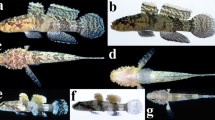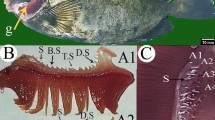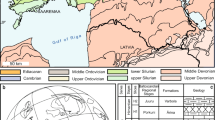Abstract
A new scorpionfish, Ebosia saya sp. nov. (Scorpaenidae: Pteroinae), is described on the basis of 10 specimens collected from the Saya de Malha Bank in depths of 95–126 m. Comparisons with two valid Indo-Pacific species, Ebosia bleekeri (Döderlein in Steindachner and Döderlein 1884) (western Pacific Ocean) and Ebosia falcata Eschmeyer and Rama-Rao 1978 (northern and eastern Indian Ocean), showed E. saya to be most similar to the latter, with both species sharing 8 (usually) anal-fin soft rays, 17 (usually) pectoral-fin rays, the elongated parietal spine of males relatively narrow and strongly falcate posterodorsally, and the pectoral fin predominantly yellow in males, whereas E. bleekeri has 7 (usually) anal-fin soft rays, 16 (usually) pectoral-fin rays, the elongated parietal spine of males relatively broad and weakly falcate, and the pectoral fins entirely red in males. However, E. saya differs from E. falcata in having 5 scale rows above the lateral line [vs. 4 or 5 (modally 4) in E. falcata], slightly greater total numbers (5–20, mean 12.3) of preocular, supraocular, and postocular spines at 60–90 mm SL (vs. 4–18, 8.4), shorter postorbital length 18.1–19.2 (mean 18.7) % SL [vs. 19.8–23.5 (21.5) % SL], and the blotch above the pectoral-fin base and blotches on the pectoral-fin membrane all relatively smaller. Fresh coloration of E. falcata is described for the first time, based on specimens from the Andaman Sea (easternmost record for the species).
















Similar content being viewed by others
References
Akihito, Iwata A, Kobayashi T, Ikeo K, Imanishi T, Ono H, Umehara Y, Hamamatsu C, Sugiyama K, Ikeda Y, Sakamoto K, Fumihito A, Ohno S, Gojobori T (2000) Evolutionary aspects of gobioid fishes based upon a phylogenetic analysis of mitochondrial cytochrome b genes. Gene 259:5–15
Bloch ME (1787) Naturgeschichte der ausländischen Fische. Berlin. Naturgeschichte der Ausländischen Fische 3:i–xii + 1–146
Chan WL, Chilvers RM (1973) Ichthyological notes: I. first records of Ebosia bleekeri (Steindachner and Döderlein) from the South China Sea. Hong Kong Fish Bull (3):103–106
Eschmeyer WN (1965) Western Atlantic scorpionfishes of the genus Scorpaena, including four new species. Bull Mar Sci 15:84–164
Eschmeyer WM (1986) Family No. 149: Scorpaenidae. In: Smith MM, Heemstra PC (ed) Smith’s sea fishes. Macmillan South Africa, Johannesburg, pp 463–478
Eschmeyer WN, Rama-Rao KV (1978) A new scorpionfish, Ebosia falcata (Scorpaenidae, Pteroinae), from the western Indian Ocean, with comments on the genus. Matsya (3):64–71
Iwamoto T, McCosker JE (2014) Deep-water fishes of the 2011 Hearst Philippine biodiversity expedition by the California Academy of Sciences. In: Williams GC, Gosliner TM (ed) The coral triangle. The 2011 Hearst Philippine biodiversity expedition. California Academy of Sciences, San Francisco, pp 263–332
Kotthaus A (1979) Fische des Indischen Ozeans. Ergebnisse der ichthyologischen Untersuchungen während der Expedition des Forschungsschiffes “Meteor” in den Indischen Ozean, Oktober 1964 bis Mai 1965. a. Systematischer Teil, XXI. Diverse Ordnungen. Meteor Forsch Ser D Biol (28):6–54
Kuriiwa K, Hanzawa N, Yoshino T, Kimura S, Nishida M (2007) Phylogenetic relationships and natural hybridization in rabbitfishes (Teleostei: Siganidae) inferred from mitochondrial and nuclear DNA analyses. Mol Phyl Evol 45:69–80
Linnaeus C (1758) Systema naturae, 10th edn, vol 1. Laurentii Salvii, Holmiae
Mandrytsa SA (2001) Lateral line system and classification of scorpaenoid fishes (Scorpaeniformes: Scorpaenoidei). Perm State Univ Press, Perm
Mandrytsa SA (2002) A new species of the genus Pteropterus (Scorpaenidae: Scorpaeniformes) from the Indian Ocean. Voprosy Ikhtiologii 42:129–130
Manilo LG, Bogorodsky SV (2003) Taxonomic composition, diversity and distribution of coastal fishes of the Arabian Sea. J Ichthyol 43:S75–S149
Matsubara K (1943) Studies on the scorpaenoid fishes of Japan (II). Trans Sigenkagaku Kenkyusyo (2):171–486
Matsunuma M, Motomura H (2011) First records of a lionfish, Pterois mombasae (Scorpaenidae: Pteroinae), from Japan, and morphological comparisons with P. antennata. Jpn J Ichthyol 58:27–40
Matsunuma M, Motomura H (2013) Newly recognized diagnostic characters of the poorly known lionfish, Pterois brevipectoralis (Scorpaenidae: Pteroinae), with notes on fresh coloration. Spec Divers 18:163–173
Matsunuma M, Sakurai M, Motomura H (2013) Revision of the Indo-West Pacific genus Brachypterois (Scorpaenidae: Pteroinae), with description of a new species from northeastern Australia. Zootaxa 3693:401–440
Miya M, Nishida M (2000) Use of mitogenomic information in teleostean molecular phylogenetics: a tree-based exploration under the maximum-parsimony optimality criterion. Mol Phyl Evol 17:437–455
Motomura H (2004a) Morphological comparison of a poorly known scorpionfish, Parapterois macrura, with a related species, P. heterura (Scorpaenidae: Pteroinae). Zool Stud 43:1–7
Motomura H (2004b) New species of scorpionfish, Scorpaena cocosensis (Scorpaeniformes: Scorpaenidae) from the Cocos Islands, Costa Rica, eastern Pacific Ocean. Copeia 2004:818–824
Motomura H (2004c) Revision of the scorpionfish genus Neosebastes (Scorpaeniformes: Neosebastidae) with descriptions of five new species. Indo-Pac Fish 37:1–75
Motomura H, Fricke R, Eschmeyer WN (2005a) Redescription of a poorly known scorpionfish, Scorpaena canariensis (Sauvage), and a first record of Pontinus leda Eschmeyer from the Northern Hemisphere (Scorpaeniformes: Scorpaenidae). Stuttg Beitr Naturk Ser A (Biol) 674:1–15
Motomura H, Johnson JW (2006) Validity of the poorly known scorpionfish, Rhinopias eschmeyeri, with redescriptions of R. frondosa and R. aphanes (Scorpaeniformes: Scorpaenidae). Copeia 2006:500–515
Motomura H, Last PR, Gomon MF (2006a) A new species of the scorpionfish genus Maxillicosta from the southeast coast of Australia, with a redescription of M. whitleyi (Scorpaeniformes: Neosebastidae). Copeia 2006:445–459
Motomura H, Last PR, Yearsley GK (2005b) Scorpaena bulacephala, a new species of scorpionfish (Scorpaeniformes: Scorpaenidae) from the northern Tasman Sea. Zootaxa 1043:17–32
Motomura H, Last PR, Yearsley GK (2006b) New species of shallow water scorpionfish (Scorpaenidae: Scorpaena) from the central coast of Western Australia. Copeia 2006:360–369
Motomura H, Paulin CD, Stewart AL (2005c) First records of Scorpaena onaria (Scorpaeniformes: Scorpaenidae) from the southwestern Pacific Ocean, and comparisons with the Northern Hemisphere population. New Zealand J Mar Freshwater Res 39:865–880
Motomura H, Poss SG, Shao K-T (2007) Scorpaena pepo, a new species of scorpionfish (Scorpaeniformes: Scorpaenidae) from northeastern Taiwan, with a review of S. onaria Jordan and Snyder. Zool Stud 46:35–45
Motomura H, Senou H (2008) A new species of the scorpionfish genus Scorpaena (Scorpaenidae) from Izu Peninsula, Pacific coast of Japan. J Fish Biol 72:1761–1772
Motomura H, Struthers CD, McGrouther MA, Stewart AL (2011b) Validity of Scorpaena jacksoniensis and a redescription of S. cardinalis, a senior synonym of S. cookii (Scorpaeniformes: Scorpaenidae). Ichthyol Res 58:315–332
Oshima M (1956) Description of a new species of scorphaenoid fishes from Shibushi, Osumi, Kagoshima Prefecture. Zool Mag Tokyo 65:236–238
Poss SG (1999) Scorpaenidae. Scorpionfishes (also, lionfishes, rockfishes, stingfishes, stonefishes, and waspfishes). In: Carpenter KE, Niem VH (ed) FAO species identification guide for fisheries purposes. The living marine resources of the western central Pacific. Vol. 4. Bony fishes part 2 (Mugilidae to Carangidae). FAO, Rome, pp 2291–2352
Quantum GIS Development Team (2014) Quantum GIS Geographic Information System. Open Source Geospatial Foundation Project. http://www.qgis.org/. Accessed 11 June 2014
Randall JE, Eschmeyer WN (2002) Revision of the Indo-Pacific scorpionfish genus Scorpaenopsis, with descriptions of eight new species. Indo-Pac Fish 34:1–79
Sabaj Pérez MH (2014) Standard symbolic codes for institutional resource collections in herpetology and ichthyology: an online reference. Version 5.0 (22 September 2014). American Society of Ichthyologists and Herpetologists, Washington, DC. http://www.asih.org/resources/standard-symbolic-codes-institutional-resource-collections-herpetology-ichthyology. Accessed 21 October 2014
Schmidt PJ (1931) Fishes of Japan, collected in 1901. Trans Pacif Comm Acad Sci USSR 2:1–176
Steindachner F, Döderlein L (1884) Beiträge zur Kenntniss der Fische Japan. (III). Denkschr Akad Wiss Wien 49:171–212, pls 1–7
Tamura K, Stecher G, Peterson D, Filipski A, and Kumar S (2013) MEGA6: Molecular Evolutionary Genetics Analysis Version 6.0. Mol Biol Evol 30:2725–2729
Temminck CJ, Schlegel H (1843) Pisces. Parts 2–4. In: de Siebold PF (ed) Fauna Japonica. Müller, Amsterdam, pp 21–72, pls 10–36
Thompson JD, Gibson TJ, Plewniak F, Jeanmougin F, Higgins DG (1997) The Clustal-X windows interface: flexible strategies for multiple sequence alignment aided by quality analysis tools. Nucl Acid Res 25:4876–4882
Acknowledgments
We are deeply grateful to M. McGrouther, A. Hay, and S. Reader (AMS); K.-T. Shao, Y.-C. Liao, and M.-Y. Lee (ASIZP); H. Endo, T. Yamakawa, N. Nakayama (BSKU), and E. Katayama (formerly BSKU); T. Nakabo, Y. Kai, A. Tokairin (FAKU), and N. Muto (formerly FAKU); M. Yabe, H. Imamura, and T. Kawai (HUMZ); R. Causse (MNHN); Y. Iwatsuki (MUFS), K. Hidaka, and K. Miyamoto (formerly MUFS); Z. Arifin, R. Pratiwi, M. Adrim, I. Alhakim, and K. Wibowo (NCIP); H.-C. Ho (NMMB); M. Gomon and D. Bray (NMV); K. Matsuura and G. Shinohara (NSMT); K.-Y. Wu (NTUM); T. Yoshino (formerly URM); K. Hoshino and M. Okamoto (SNFR); J. Williams (USNM); S. Morrison (WAM); R. Thiel and I. Eidus (ZMH); and K. Sakamoto (ZUMT) for their kind hospitality during the first author’s visits to their institutions. We are also grateful to R. Feeney (LACM) for providing opportunities to examine specimens, H.-C. Ho (MNHB) for donating specimens, H. Endo and T. Kawai for providing photographs of fresh E. bleekeri and E. saya, respectively, and Y. Haraguchi, students, and other KAUM volunteers for curatorial assistance and sampling specimens. The first author is especially grateful to S. Chiba (NSMT) for advice with molecular analysis and M. Sakurai (The Kagoshima Immaculate Heart College) for advice with gonad examinations. G. Hardy (Ngunguru, New Zealand) read the manuscript and provided help with English. Specimens from Pakistan were donated to KAUM from Marine Fisheries Department, Government of Pakistan, and P. Psomadakis (FAO, Rome). This study was supported in part by Grants-in-Aid for Scientific Research (A: 26241027, B: 24370041, and C: 23580259 and 26450265) from the Japan Society for the Promotion of Science, Tokyo, Japan (JSPS), JSPS Asian Core Program “Establishment of Research and Education Network on Coastal Marine Science in Southeast Asia”, JSPS International Training Program “Protect Diversity of Bioresources in the Tropical Area”, the Coastal Area Capability Enhancement in Southeast Asia Project of the Research Institute for Humanity and Nature, Kyoto, Japan, and the “Biological Properties of Biodiversity Hotspots in Japan” project of the National Museum of Nature and Science, Tsukuba, Japan, and by the grant awarded to the first author from the Mikimoto Fund for Marine Ecology.
Author information
Authors and Affiliations
Corresponding author
Additional information
This article was registered in the Official Register of Zoological Nomenclature (ZooBank) as B264ADE4-84F9-42A4-AFB6-8EA791FF671C.
This article was published as an Online First article on the online publication date shown on this page. The article should be cited by using the doi number.
About this article
Cite this article
Matsunuma, M., Motomura, H. A new species of scorpionfish, Ebosia saya (Scorpaenidae: Pteroinae), from the western Indian Ocean and notes on fresh coloration of Ebosia falcata . Ichthyol Res 62, 293–312 (2015). https://doi.org/10.1007/s10228-014-0445-4
Received:
Revised:
Accepted:
Published:
Issue Date:
DOI: https://doi.org/10.1007/s10228-014-0445-4




